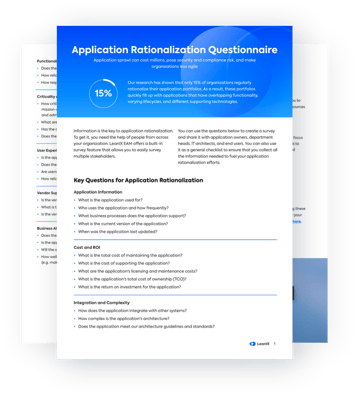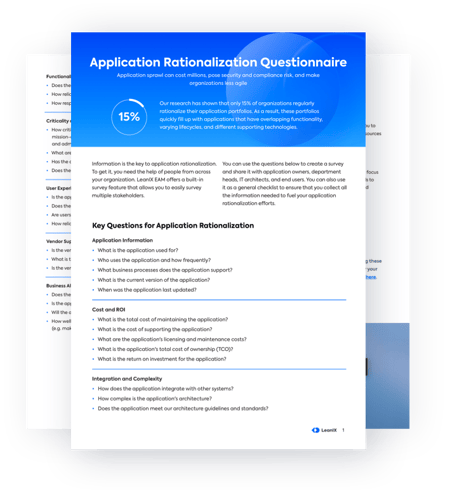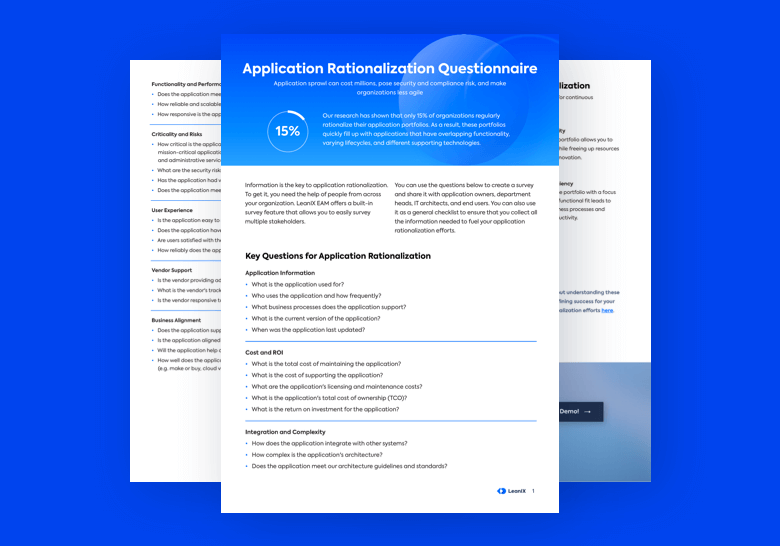[CONTINUED]
Main questionnaire sections
Understanding the application
The first step in an application rationalization process is to understand the apps in an organization's portfolio. The following questions can help to gain a better understanding:
- What is the application used for?
- Who uses the application and how frequently?
- What business processes does the application support?
Result: Identify the primary purpose of the application, its level of usage, and its role in supporting business processes.
Evaluating costs
One of the key objectives of application rationalization is to reduce costs associated with an organization's application portfolio. Add the following questions to evaluate the costs of each application:
- What are the application's licensing and maintenance costs?
- What is the application's total cost of ownership (TCO)?
Result: Identify the costs associated with licensing, maintenance, and other expenses related to the application over its lifecycle.
📚 Related: SaaS Spend Optimization
Assessing integration and complexity
Another important aspect of application rationalization is understanding the integration and complexity of an application portfolio. Ask these questions to assess integration and complexity:
- How does the application integrate with other systems?
- How complex is the application's architecture?
Result: Identify any integration requirements or complexities associated with the application.
Determining criticality and risks
To prioritize which applications should be the first to act on, it's important to assess each application's criticality and risks. Questions to determine criticality and risks:
- How critical is the application to the business? (Application criticality labels can be defined as; mission-critical applications, business-critical applications, business operational applications, and administrative service applications)
- What are the security risks associated with the application?
Result: Identify the application's criticality to the business, and its potential impact on revenue, customers, and other key business metrics. It also helps uncover any potential security risks associated with the application.
📚 Related: Assess Application Criticality Levels
Evaluating functionality and performance
To ensure that an organization's application portfolio is meeting its needs, it's important to evaluate the functionality and performance of each application. The following questions can help to evaluate functionality and performance:
- Does the application meet business requirements?
- How reliable and scalable is the application?
- How responsive is the application?
Result: Identify any gaps in functionality and performance.
📚 Related: Application Portfolio Assessment
Assessing user experience
The user experience is a critical factor in the success of any application. Assess the user experience with these questions:
- Is the application easy to use and navigate?
- Does the application have a modern and intuitive interface?
- Are users satisfied with the application's performance and usability?
Result: Identify any user experience issues that may be impacting the application's effectiveness.
Evaluating vendor support
Vendor support is a critical factor in the ongoing maintenance and support of an application. The following questions can help to evaluate vendor support:
- Is the vendor providing adequate support and maintenance?
- What is the vendor's track record for resolving issues?
- Is the vendor responsive to requests for support and maintenance?
Result: Identify any issues with vendor support.
📚 Related: SaaS Evaluation Template
Determining business alignment
The final step in an application rationalization process is to evaluate how well an application aligns with an organization's overall business strategy. The following questions can help to determine business alignment:
- Does the application support the organization's business goals and objectives?
- Is the application aligned with the organization's technology roadmap?
- Will the application help to drive innovation and growth for the organization?
Result: Identify whether an application is helping to drive the organization's success or if it's holding it back.
Application rationalization questionnaire template
When you use LeanIX EAM, you don't have any use for this template, if not, follow along.
Here is a template you can copy into your medium of preference, and share with application owners, department heads, and other IT architects.
Introduction: The following questionnaire is designed to help us evaluate our application portfolio. Please answer the following questions for each application in your portfolio.
Application Information:
- What is the name of the application?
- What is the purpose of the application?
- Who are the primary users of the application?
- What is the current version of the application?
- When was the application last updated?
Cost and ROI:
- What is the total cost of ownership (TCO) for the application?
- What is the return on investment for the application?
- What is the total cost of maintaining the application?
- What is the cost of supporting the application?
Functionality and Performance:
- Does the application meet business requirements?
- How reliable and scalable is the application?
- How responsive is the application?
User Experience:
- Is the application easy to use and navigate?
- Does the application have a modern and intuitive interface?
- Are users satisfied with the application's performance and usability?
Vendor Support:
- Is the vendor providing adequate support and maintenance?
- What is the vendor's track record for resolving issues?
- Is the vendor responsive to requests for support and maintenance?
Business Alignment:
- Does the application support the organization's business goals and objectives?
- Is the application aligned with the organization's technology roadmap?
- Will the application help to drive innovation and growth for the organization?
Conclusion: By answering these questions, we will be able to optimize our application portfolio.
Conclusion
An application rationalization questionnaire is a powerful starting point for smaller organizations looking to streamline their application portfolio.
By evaluating costs, functionality, performance, user experience, vendor support, and business alignment, organizations can optimize their application portfolio and drive greater success.
Once the application inventory size increases, it's essential to automate data collection and reporting, and implement the right EA tool.


/EN/White-Paper/EN-IDC-Inforbrief-Application-Rationalization-Portfolio-Management-Thumbnail_v2.png?width=260&height=171&name=EN-IDC-Inforbrief-Application-Rationalization-Portfolio-Management-Thumbnail_v2.png)

/EN/Reports/Thumbnail-Gartner%20720x500.png?width=260&height=171&name=Thumbnail-Gartner%20720x500.png)


